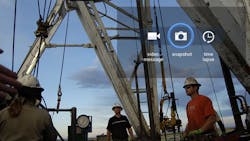Looking to enhance the experience—and productivity—of the engineers and technicians working in the plant and on the factory floor, APX Labs this week announced a new version of its Skylight software for wearable technology that adds work management streams, voice commands, and support for smart watches.
Skylight is designed to enable hands-on workers to access the information, applications, and systems necessary to do their jobs, without the interruption of turning away to use computers, phones, or paper manuals. The Skylight technology was originally used in military applications, such as on smart helmets worn by soldiers. In recent years, APX has been designing smart glasses applications for manufacturing and field service and has customers in the automotive, aerospace, oil and gas and energy industries.
As an extension to enterprise resource management (ERP) and asset management systems, the Skylight software can push detailed instructions to someone working on a complicated wiring system, for example, as well as deliver alerts, capture images, share documents, conduct video calls, and pull up reference materials. The information is displayed on the smart glasses in the person’s line of vision so they can continue working while gathering information or next steps.
The latest version, Skylight R5, adds a feature called Workstreams, a work management application that gives each user the instructions, content, and help they need for their job, be it a service or work order for equipment installation or repair, or a task list. The embedded content can be delivered in a diagram, schematic, or a video, providing individual steps required to get the job done. This feature is also important for transferring knowledge between expert and novice workers. An expert can take a video while they complete a task and store that content as part of the work stream for someone else to access when they are doing a similar job in the future.
The ability to capturing content as part of the work management system is an important function of wearable technology says Ed English, chief product officer at APX Labs. “People think wearable technology is just a display, but it also captures data about what is being worked on to enable best practices or to document work.” For example, while repairing a pump, there may be a step that includes taking a picture of the work when done to document that the job is finished. That picture is now an embedded action associated with the work order so the next time this pump comes into play, this picture is already tagged and ready for use, he says.
The new release also supports smartwatches, including Android Wear devices with a planned software upgrade for Apple Watch. It is a good device for cases where the user needs quick instructions, checklists, or alerts, especially when in a highly mobile environment like material handling where a quick instruction feed may say “go to bay 20 and drop pallets in zone 3,” for example.
“A powerful thing about Skylight is that there are a variety of different scenarios in an organization where wearables and hands-on work apply, and Skylight is built to handle all of the devices, from smart glasses and watches to motion trackers, and laser scanners," English says. "With this software system you do not have to worry about the individual elements of the wearable environment."
Lastly, Skylight has added an embedded voice control system in R5. This allows the user to search long lists of things via voice shortcuts. For example, the user can pull up work order by saying the work order number and “confirm,” and then navigate and make selections, such as “insert wire” to get Skylight to find more specific instructions.
Skylight connects via WiFi for live data feeds and video calls. However, if in an environment where there are intermittent WiFi connections, work streams can be set and stored to a device and information syncs up with the backend when the wireless connection is restored.
“We are trying to make current processes easier,” English says, noting the company has seen a high adoption rate of wearable technology in manufacturing. “If a manufacturer can improve quality, productivity, and safety, even by a little bit, the ROI becomes very compelling. Businesses realize they can have a connected workforce and help them to work better.”
About the Author
Stephanie Neil
Editor-in-Chief, OEM Magazine

Leaders relevant to this article:
